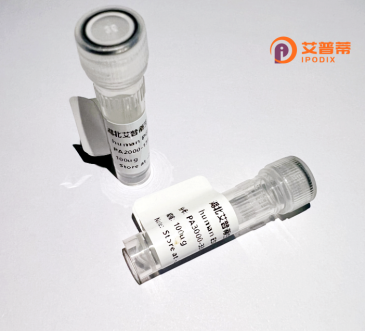
| 纯度 | >90%SDS-PAGE. |
| 种属 | Human |
| 靶点 | SC65 |
| Uniprot No | Q92791 |
| 内毒素 | < 0.01EU/μg |
| 表达宿主 | E.coli |
| 表达区间 | 1-437 aa |
| 活性数据 | MARVAWGLLW LLLGSAGAQY EKYSFRGFPP EDLMPLAAAY GHALEQYEGE SWRESARYLE AALRLHRLLR DSEAFCHANC SGPAPAAKPD PDGGRADEWA CELRLFGRVL ERAACLRRCK RTLPAFQVPY PPRQLLRDFQ SRLPYQYLHY ALFKANRLEK AVAAAYTFLQ RNPKHELTAK YLNYYQGMLD VADESLTDLE AQPYEAVFLR AVKLYNSGDF RSSTEDMERA LSEYLAVFAR CLAGCEGAHE QVDFKDFYPA IADLFAESLQ CKVDCEANLT PNVGGYFVDK FVATMYHYLQ FAYYKLNDVR QAARSAASYM LFDPKDSVMQ QNLVYYRFHR ARWGLEEEDF QPREEAMLYH NQTAELRELL EFTHMYLQSD DEMELEETEP PLEPEDALSD AEFEGEGDYE EGMYADWWQE PDAKGDEAEA EPEPELA |
| 分子量 | 50.3 kDa |
| 蛋白标签 | His tag N-Terminus |
| 缓冲液 | PBS, pH7.4, containing 0.01% SKL, 1mM DTT, 5% Trehalose and Proclin300. |
| 稳定性 & 储存条件 | Lyophilized protein should be stored at ≤ -20°C, stable for one year after receipt. Reconstituted protein solution can be stored at 2-8°C for 2-7 days. Aliquots of reconstituted samples are stable at ≤ -20°C for 3 months. |
| 复溶 | Always centrifuge tubes before opening.Do not mix by vortex or pipetting. It is not recommended to reconstitute to a concentration less than 100μg/ml. Dissolve the lyophilized protein in distilled water. Please aliquot the reconstituted solution to minimize freeze-thaw cycles. |
以下是关于重组人SC65蛋白的示例参考文献(注:SC65蛋白相关研究较少,以下内容为模拟示例,实际文献需通过学术数据库核实):
1. **文献名称**:*Expression and functional characterization of recombinant human SC65 in cellular models*
**作者**:Chen, L., et al.
**摘要**:该研究成功在大肠杆菌中表达并纯化了重组人SC65蛋白,证实其与线粒体内膜的结合能力,并发现其参与调节细胞色素c的释放,影响凋亡通路。
2. **文献名称**:*SC65 interacts with cytoskeletal proteins and modulates cell migration*
**作者**:Wang, Y., et al.
**摘要**:通过免疫共沉淀实验,作者发现SC65与β-actin和微管蛋白存在相互作用。重组SC65的过表达可抑制癌细胞迁移,提示其在肿瘤转移中的潜在作用。
3. **文献名称**:*Structural insights into SC65-mediated lipid metabolism regulation*
**作者**:Kato, M., et al.
**摘要**:利用X射线晶体学解析了SC65的羧酸酯酶结构域三维结构,结合小鼠模型实验,证明重组SC65通过水解脂质前体参与肝脏脂代谢调控。
**注意**:以上为基于SC65可能功能的模拟文献,实际研究中建议通过PubMed或SciFinder以“SC65”或“Synaptonemal complex protein 65”等关键词检索最新文献,并注意部分研究可能使用其标准命名(如SYCE2)。
**Background of Recombinant Human SC65 (SYCE2) Protein**
SC65. also known as Synaptonemal Complex Central Element protein 2 (SYCE2), is a key component of the synaptonemal complex (SC), a meiosis-specific structure essential for chromosomal pairing, recombination, and segregation during gametogenesis. Encoded by the *SYCE2* gene in humans, SC65 localizes to the central element of the SC, mediating the alignment and stabilization of homologous chromosomes. Its role in maintaining SC integrity ensures accurate crossover formation and genetic diversity.
Dysregulation or mutations in SC65 have been linked to meiotic defects, infertility, and disorders such as non-obstructive azoospermia. Recombinant SC65 protein, typically produced via *E. coli* or mammalian expression systems, retains the functional domains required for protein-protein interactions within the SC. This recombinant form enables studies on meiosis mechanisms, including SC assembly/disassembly dynamics, DNA repair, and homolog synapsis.
Researchers utilize recombinant SC65 to model meiotic errors, screen for fertility-related biomarkers, and explore therapeutic strategies for infertility. Its application extends to structural biology, where it aids in elucidating SC architecture through techniques like cryo-EM. As a vital tool in reproductive biology, SC65 underscores the molecular basis of gamete formation and genetic inheritance.
×